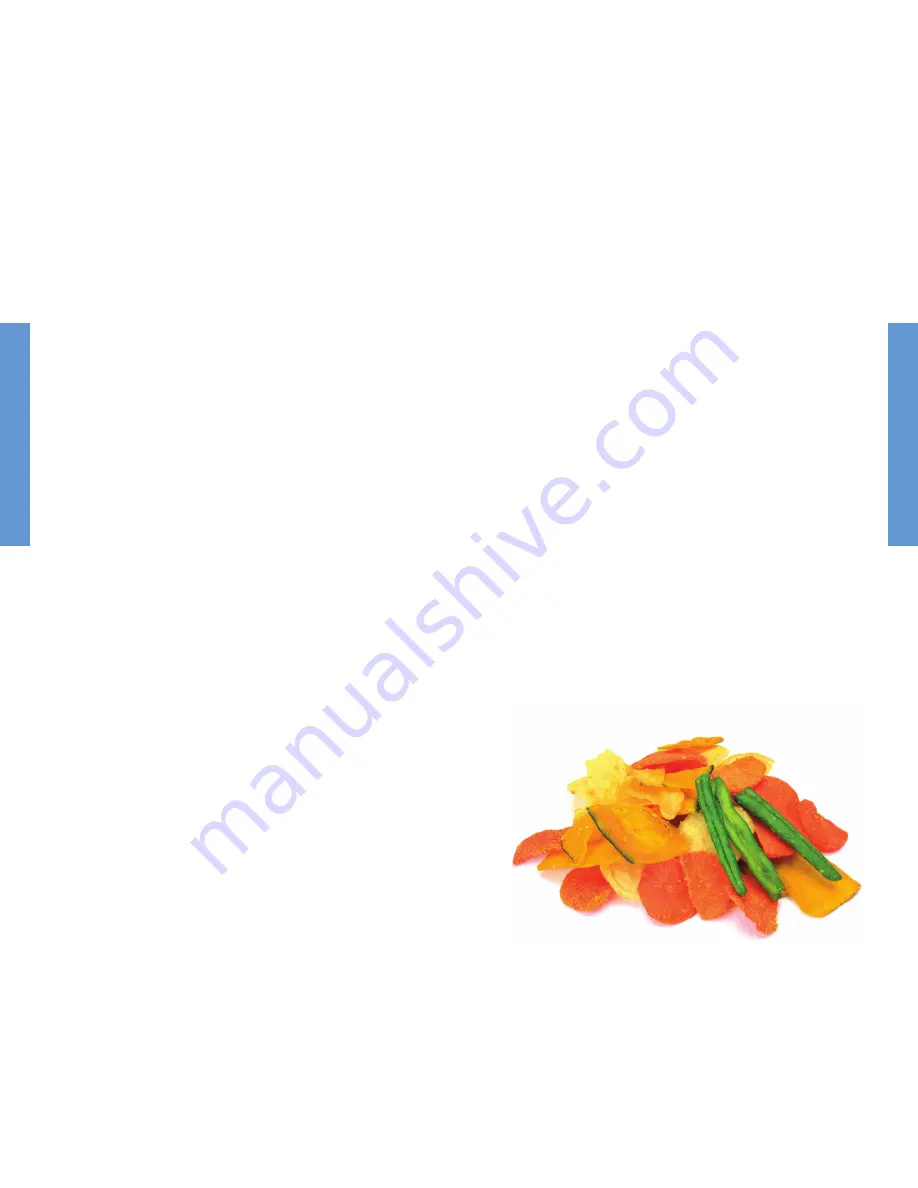
18
FOOD SELECTION & PREP
ARA
TION
FOOD SELECTION & PREP
ARA
TION
Pre-Treatment for Fruit
Preparation for drying can include dipping fruit into their own juices, such as lemons,
limes and other citrus fruit.
Sodium Bisulfite (food grade) can also be used. Use a ratio of 1 teaspoon to one quart
of water. Dipping fruit into the water mixture preserves color and nutrients.
Steaming can also be used to set color in fruit. Steam only a few minutes over a gentle
heat. Remove and cool completely. Dry with a paper towel and place in the dehydrator.
Drying Vegetables – Hints & Tips
As with fruit, the critical component of drying vegetables is to start with the most
fresh, crisp vegetables at the peak of ripeness.
• Unripe vegetables often have an extremely bitter, acidic flavor. Avoid any that are
under-ripe or over-ripe for best flavor results.
• Wash and dry vegetables just before drying to remove any debris or dirt.
• Do not use vegetables that have blemishes, evidence of bug infestation or worms, or
discoloration.
• Cut off parts of vegetables that appear to be bruised or damaged in transit.
• Discard seeds, stems, rinds and other inedible parts of the vegetable.
• Peel vegetables; almost all vegetables should be peeled or cut before drying. Rinds
or peels lend a bitter or unappetizing taste or texture.
• Slice or cut vegetables as desired (see notes following).
Cutting & Slicing Vegetables – Hints & Tips
Create uniform pieces for drying; slice or quarter vegetables as needed. Pieces should
be no larger than 1½ -2 inches in diameter. Cut thin slices of dense vegetables, such
as potatoes and beets. Trim ends and leave some vegetables whole, such as asparagus
and green beans.
Pre-treatment of vegetables is usually recommended and is best accomplished by
blanching over boiling water for 2 to 3 minutes, just long enough to set the color and
remove acidic flavors. After blanching, arrange on the Drying Trays.
Drying Meat – Hints & Tips
• Meat must be sliced very thinly to be dried. Partially freeze meat for up to 1 hour.
Remove and slice thinly across the grain. Place on the Jerky & Sausage Specialty Tray
right away.
• Use the Jerky & Sausage Specialty Tray when drying meat. Drape jerky strips or hang
sausage strings over the Tray to dry.
• Seafood fillets should also be thinly sliced. If needed, partially freeze the fish first, thin
thinly sliced with a sharp knife. Remove any bones, even small ones, for best results.
• Create a great low fat Teriyaki Chicken Jerky by thinly slicing chicken breasts and
marinating in Teriyaki sauce for 1 hour prior to drying. Arrange on the Jerky &
Sausage Specialty Tray right away. When done, add crushed red pepper, chili powder
or other spices to kick up the flavor.
Drying Nuts – Hints & Tips
• To reduce enzymes, first soak raw nuts in plenty of water for 24 hours before drying
(cashews for 6 hours). The nuts will expand in size – allow plenty of room in the jar or
bowl. Drain the nuts and dry until crispy, about 10 hours. Store in air-tight containers.
Drying Herbs & Edible Flowers – Hints & Tips
• Rinse thoroughly in cold water and gently dry. Remove any dead or discolored leaves.
Spread on Drying Trays and dry for up to 8 hours. Remove and cool. Break or crush
the herbs and store in a dark, cool place in a self-sealing container. Flowers can be
dried in much the same way and used as garnishes or for flavoring.
CAUTION: Be confident that the flowers and herbs selected for drying are edible and
pose no danger or threat if consumed. If in doubt, throw away the herbs or flowers.
Summary of Contents for GFD1750
Page 1: ...CUT DRY DEHYDRATOR MODEL GFD1750 GFD1850 ...
Page 14: ...www gourmia com ...
































